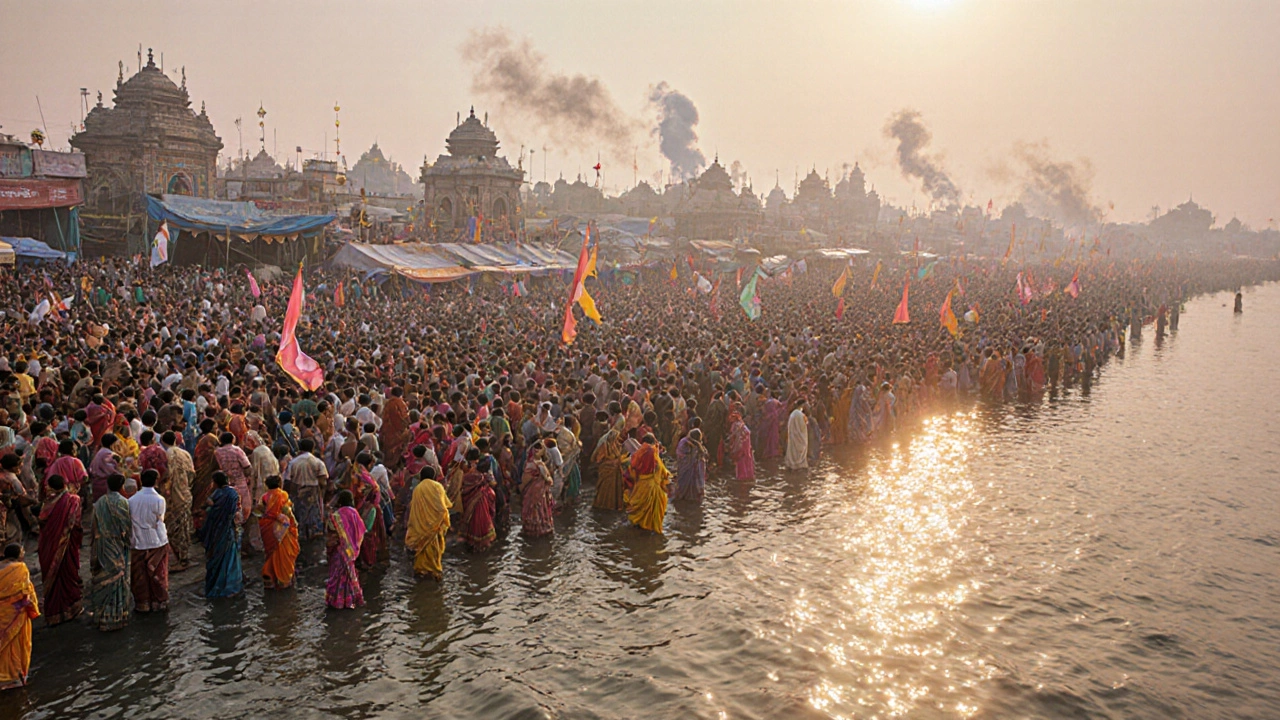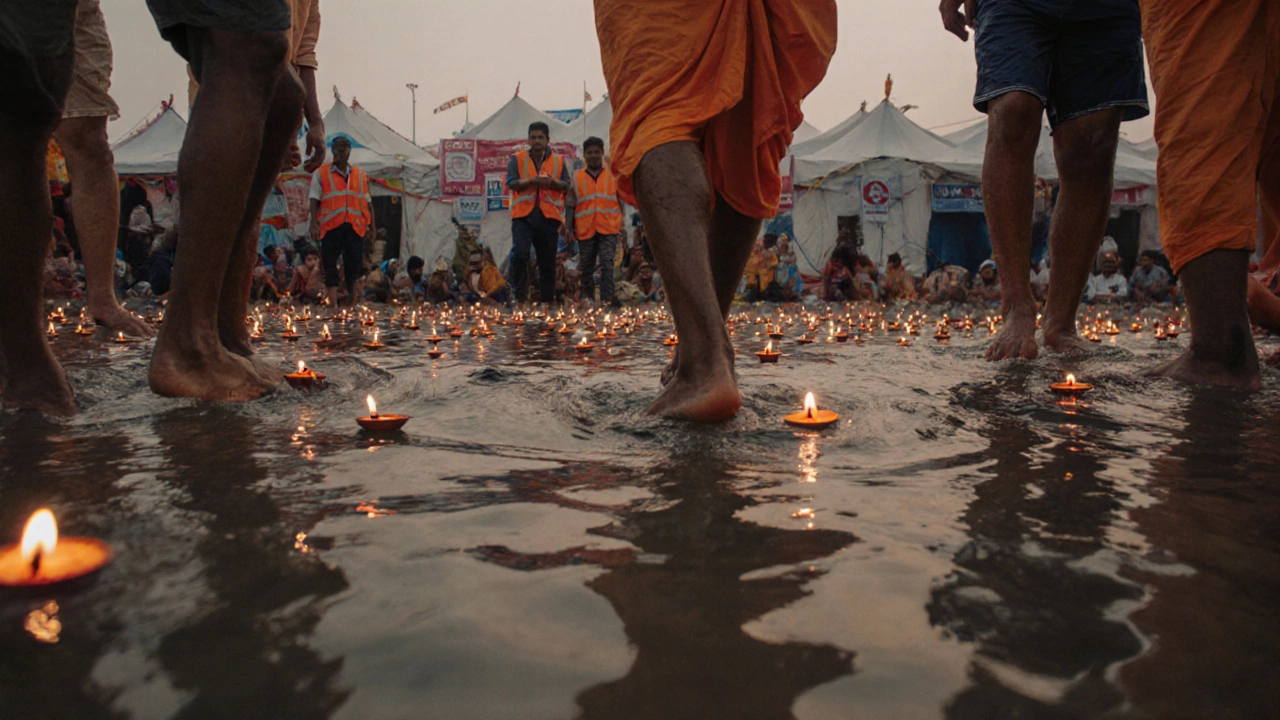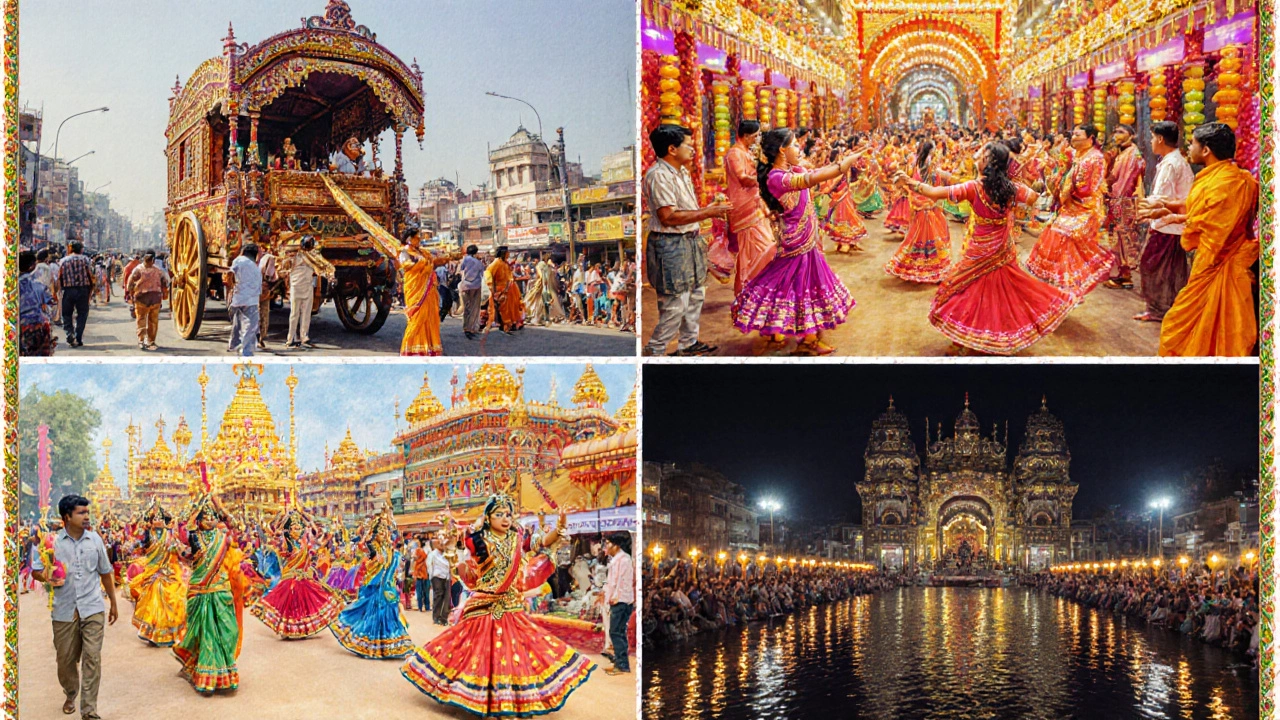India’s Biggest Temple Festival: Kumbh Mela and Other Grand Celebrations
 Oct, 18 2025
Oct, 18 2025
Festival Comparison Calculator
Compare India's Temple Festivals
Select festivals to compare their key metrics and see how they stack up against each other.
Select Festivals to Compare
Comparison Results
Select festivals to see comparison metrics
Insider Tip
For the most accurate comparison, select 3-4 festivals at most. The Kumbh Mela stands out with its 30+ million attendees in a single day and spans multiple locations over 45 days, making it the largest festival by all metrics.
Quick Takeaways
- The Kumbh Mela, rotating among four cities, draws over 30 million pilgrims in a single cycle, making it the biggest temple festival India has to offer.
- Rath Yatra in Puri, Durga Puja in Kolkata, Navratri in Gujarat, Brahmotsavam in Tirumala, and Mahashivratri in Varanasi each attract millions and offer unique cultural flavors.
- Key factors for "biggest" include visitor numbers, geographic spread, duration, and religious significance.
- Plan early, secure accommodations weeks ahead, and respect local customs for a smooth pilgrimage experience.
- Use the checklist at the end to avoid common travel hiccups.
When you hear the word "festival" in India, you probably picture a sea of colorful crowds, endless chants, and temples lit up like fireworks. But which celebration actually holds the title of the biggest? The answer lands on a massive congregation that rotates among four holy cities, drawing tens of millions of devotees in a single cycle. Below we break down why that festival tops the list, compare it with other giant temple events, and give you a practical roadmap for visiting any of them.
Kumbh Mela is a Hindu pilgrimage that takes place every 12 years in one of four locations - Prayagraj (formerly Allahabad), Haridwar, Ujjain, and Nashik - where the sacred rivers Ganges, Yamuna, and the mythical Saraswati converge. It is not a single‑day fair; the festivities span about two months, featuring ritual baths, spiritual discourses, and cultural performances. According to the Ministry of Tourism, the 2019 Kumbh Mela in Prayagraj recorded an estimated 30 million visitors on the main bathing day alone, eclipsing any other temple festival in both scale and media coverage.What Makes a Temple Festival the "Biggest"?
Before we crown a champion, it helps to define the metrics we use:
- Attendance - Total number of pilgrims or tourists over the entire event.
- Geographic spread - Whether the festival is confined to a single temple or spans multiple sites.
- Duration - Longer festivals can naturally accumulate larger crowds.
- Religious significance - Events tied to major mythological cycles tend to attract broader participation.
- Economic impact - Tourist spend, local employment, and infrastructure development are indirect signs of size.
Using these five pillars, Kumbh Mela scores the highest on every count, especially attendance and geographic spread, because it rotates among four major pilgrimage hubs.
Kumbh Mela - The Undisputed Giant
Every 12 years, the Kumbh Mela transforms ordinary riverbanks into bustling spiritual megacities. Here are the core features that set it apart:
- Attendance: Peak day numbers exceed 30 million; cumulative attendance for a full cycle can top 100 million.
- Locations: Four cities - Prayagraj (Triveni Sangam), Haridwar (Ganga), Ujjain (Shipra), Nashik (Godavari) - each hosting a distinct "Mela".
- Duration: Usually 45 days of intensified activity, with smaller pre‑ and post‑events extending up to three months.
- Rituals: Mass "Shahi Snan" (royal bath), religious discourses by eminent saints, cultural performances, and massive temporary infrastructure (tent cities, medical camps, sanitation).
- Economic impact: The 2013 Kumbh Mela generated an estimated US$3.4 billion in direct and indirect revenue for the host region.
Travel logistics are a major challenge. The Indian government sets up a dedicated "Mela" transport network, including special trains, chartered buses, and temporary rail stations. Booking a stay within the tent city requires registration months in advance, and most tourists opt for hotels in nearby towns where prices spike by 150 % during the event.

Other Massive Temple Festivals Worth Experiencing
While Kumbh Mela holds the crown, India boasts several other festivals that rival it in scale, cultural richness, and pilgrim enthusiasm.
Rath Yatra in Puri, Odisha, honors Lord Jagannath’s journey from the Jagannath Temple to the Gundicha Temple. Every June, three massive wooden chariots-one each for Jagannath, Balabhadra, and Subhadra-are pulled by lakhs of devotees. The 2024 edition saw over 5 million participants across the three‑day procession. Durga Puja in Kolkata, West Bengal, transforms the city into a canvas of art, music, and devotion. Though primarily a goddess festival, the elaborate pandals (temporary structures) are built around temple-like designs, drawing more than 10 million visitors each September‑October. Navratri in Gujarat is a nine‑night celebration of the goddess Durga, featuring nightly Garba dances in open-air venues that often surround historic temples. In 2023, the city of Ahmedabad recorded an estimated 8 million attendees over the nine nights. Brahmotsavam at the Tirumala Venkateswara Temple in Andhra Pradesh spans nine days of processions, firework displays, and special poojas. With over 50,000 daily pilgrims during peak days, the festival’s cumulative attendance easily reaches several hundred thousand. Mahashivratri in Varanasi centers around the Kashi Vishwanath Temple, where devotees fast, chant, and take midnight dips in the Ganges. The 2025 celebration attracted roughly 3 million pilgrims, making it one of the most attended Shiva‑focused festivals.Comparison of India’s Top Temple Festivals
| Festival | Primary Location(s) | Typical Month(s) | Average Attendance (peak day) | Duration |
|---|---|---|---|---|
| Kumbh Mela | Prayagraj, Haridwar, Ujjain, Nashik | Feb-Mar (Haridwar) / Apr-May (Ujjain) / Oct-Nov (Prayagraj) / Oct-Nov (Nashik) | 30 million+ | 45 days (main) + 3 months total |
| Rath Yatra | Puri, Odisha | June‑July | 5 million+ | 3 days |
| Durga Puja | Kolkata, West Bengal | Sept‑Oct | 10 million+ | 5 days (plus preparatory events) |
| Navratri (Garba) | Ahmedabad, Gujarat | Sept‑Oct | 8 million+ | 9 nights |
| Brahmotsavam | Tirumala, Andhra Pradesh | Oct‑Nov | 50,000‑100,000 (daily) | 9 days |
| Mahashivratri | Varanasi, Uttar Pradesh | Feb‑Mar | 3 million+ | 1 night (main) + 2 days prep |
Planning Your Visit: Logistics, Tips, and Insider Tricks
Going to a mega‑festival can feel like planning a mini‑expedition. Here are the steps that keep the experience joyful rather than stressful:
- Pick the festival that matches your interest. If you crave massive crowds and a spiritual overload, Kumbh Mela is the choice. For vibrant dance and art, Navratri in Gujarat shines.
- Book accommodation early. Hotels near the core site fill up 2‑3 months before the event. Consider staying in nearby towns and using local trains or shared auto‑rickshaws for daily commutes.
- Register for any official pilgrim passes. Kumbh Mela, for instance, offers a free "Mela Pass" that grants entry to medical camps and sanitation facilities.
- Pack wisely. Comfortable shoes, breathable clothing, a reusable water bottle, and a small towel are essentials. Most festivals prohibit plastic, so bring a cloth bag.
- Respect local customs. Many festivals have dress codes (e.g., covering shoulders at Hindu shrines) and strict rules about photography inside sanctums.
- Stay connected. Download the official event app (available for Kumbh Mela and Durga Puja) for real‑time crowd maps and emergency contacts.
- Prepare for crowds. Carry a basic first‑aid kit, keep cash in small denominations, and have a backup plan in case the main route gets blocked.
By following this checklist, you’ll avoid the common pitfalls that trip up first‑time pilgrims.

Travel Checklist for Indian Temple Festivals
- Passport & visa (if you’re an international traveler)
- Festival‑specific permit or pass (if required)
- Confirmed accommodation (hotel or official tent)
- Local transport tickets (rail or bus)
- Lightweight, modest clothing and a warm shawl for early morning baths
- Reusable water bottle, hand sanitizer, and a small towel
- Cash (₹500‑₹2000 notes) and a debit/credit card
- Portable charger and a printed copy of emergency contacts
- Basic first‑aid kit (band-aids, antiseptic wipes, pain reliever)
- Respectful attitude and patience
Frequently Asked Questions
When is the next Kumbh Mela scheduled?
The upcoming Kumbh Mela will be held in Haridwar in 2027, followed by the Ujjain Mela in 2029. Dates are set according to the Hindu luni‑solar calendar and announced by the Ministry of Culture each year.
Do I need a visa to attend Indian temple festivals?
International visitors need a valid tourist visa for India. The festival itself does not grant any special entry rights, so obtain your visa well in advance.
Is it safe to travel during these massive gatherings?
Yes, provided you follow local guidelines. The Indian government deploys additional police, medical teams, and crowd‑control measures for each festival. Keep your belongings secure and stay in groups when navigating dense areas.
What are the best travel months for temple festivals?
Most major festivals occur between September and November (Durga Puja, Navratri, Brahmotsavam) or in February‑March (Mahashivratri, Kumbh Haridwar). Choose based on climate preference and festival calendar.
Can I take photos inside the temples during the festivals?
Photography is allowed in most outer courtyards, but many sanctums forbid any cameras. Look for signage or ask a local priest before snapping pictures.
Next Steps and Troubleshooting
If you hit a snag-like a full hotel or a sudden itinerary change-here’s what to do:
- Full hotels? Check nearby towns for guesthouses or reputable Airbnb listings. Train stations often have budget dormitories during festivals.
- Transport delays? Keep a backup bus or share‑taxi number saved on your phone. Many festivals have dedicated shuttle services that run every hour.
- Health concerns? Carry a copy of your medical records and stay hydrated. The official medical camps provide free basic care; locate the nearest one via the event app.
- Lost belongings? Report to the nearest police outpost-most festivals have a dedicated “Lost & Found” desk.
With these tools in hand, you’re ready to witness the awe-inspiring scale of India’s temple festivals-especially the unrivaled Kumbh Mela. Pack your bags, respect the rituals, and let the sea of devotion sweep you into an unforgettable cultural journey.